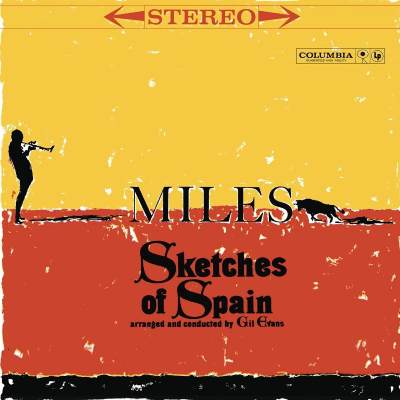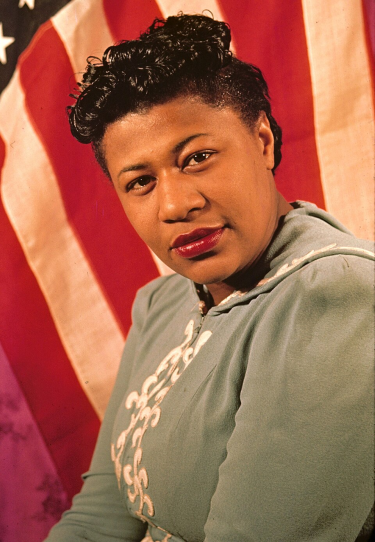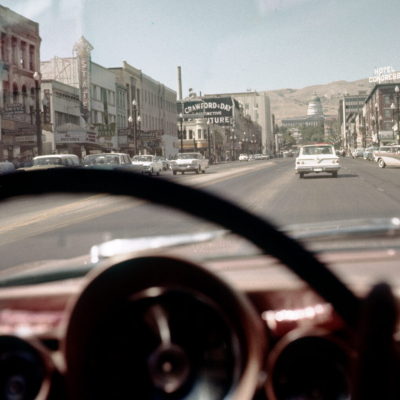.
.

.
.
Sketches of Spain
I’ve never seen much of Spain.
A business trip to Barcelona.
A commuter ride to Girona. Salvador
Dali’s museum. A stop in Sitges
where ivory beach sand abets
a shimmered turquoise sea.
Thanks to Miles Davis and Gil Evans,
Spain is always at hand. When I
want to see a world beyond my own,
this is my ticket. I need no plane,
no ship, no train. All is need is here.
In my living room. On vinyl.
Concierto de Aranjuez moves, soothes,
sings, singes skin. Like a slow burn.
Like a hot streak. Flugelhorn born again.
Reborn. It slithers, sails, seduces.
Ancient guitars replaced by supple,
silvered horns, silken ribbons of sun.
Sounds hovers in the air like ghosts.
But we welcome their caress.
We want to reach out, leap upward.
In the distance, beyond our vision,
drumbeats pulse, castanets whisper,
bells ring out prayer tapestries.
Tambourines echo. Soft. Subtle.
Chords rise like clouds. Strings tease
us, tempt us. In Saeta, an Andalusian
folk tale calls us to processions along
cobblestoned streets, veiled in lace
mantillas, in praise of ways that god
finds perfection hidden beneath clay
tiled rooftops, whitewashed walls
or peeking out from an earthenware
pot filled with crimson carnations.
Mosaic tiles lavish us with legends,
each spot of color radiant with meaning.
Will ‘O the Wisp spins, weaves,
waves farewell to phantoms
we no longer need or want. Next,
Pan Piper translates a dialogue between
between flute and horn, past and present.
We hear what we crave, not what exists.
As we proceed, new languages form.
We cradle them like precious gems.
We learn to appreciate their luster,
linger over each new conjugation as if
it were a just-discovered constellation.
Listen carefully, savor notes of love, loss.
Solea transports us further across new
continents. We pursue desire in every
in every pulsing phrase, every tone, trill.
Combustion points of light and dark
simmer beneath chambered corridors,
soaring cathedrals, stained glass archways.
So I must don my cinnamon red flamenco
dress, hold up my pear-shaped castanets,
black as onyx, stomp my stiletto heels.
As I flounce, phosphorescent chiffon ruffles.
I am suddenly as brassy as a rose-colored
flamingo. Watch me spin, twist, swing, soar.
.
by Mary K O’Melveny
.
___
.
Solea
A trumpet cries over orchestral waves,
mourns like a wounded beast,
demands attention; orchestra swells,
trumpet riding its waves; silence;
then trumpet reappears softly in distance;
drums start a flamenco beat; horns quietly appear;
Miles’ horn rises above the beat beneath; as it builds,
the horn mourns, the horn mourns, and drums beat;
the trumpet cries from the heart, from man’s bones;
this is a funeral for mankind, for all life, lost, lost,
lost again and again; horn vanishes, and orchestra
lays a groundwork for the trumpet to reappear
and fade; drums continue, and trumpet dances in a wild
pageant of death; the orchestra remains together; the horn
sounds; pain, all pain, all kinds of pain, and the horn rises;
joined by the orchestra, the trumpet screams, disappears,
reappears in a rapid complaint above the muted orchestra;
the drums dance a wild dance; enter the orchestra swelling,
and the trumpet hangs high above in pure pain, pure emptying
of pain upon the earth, the dying earth, and the drums march on;
the orchestra rises; the trumpet weeps; the trumpet weeps,
and then rises above the marching orchestra, and the horn
dies in a wail seeping into the earth; the orchestra marches on;
then builds and builds, and the trumpet climbs, steps high above
filled with tears, filled with pain, filled with all mankind has lost;
as horn slips down into earth, the orchestra vanishes, save for drums’
steady martial dance beneath all else; the trumpet returns,
filled with all of life’s pain, all of life’s losses; the orchestral dance
lays out beneath the horn’s bleak plaint for all lost, all destroyed,
all no longer present to be loved; horn slips into earth; orchestra
whispers beneath purest song of Miles’ horn, weeping horn, which slowly
slips into earth, the drums continuing a slow march to nothingness.
by Michael L. Newell
.
___
.
Sketches of Spain or Guernica
The earth has got a fever of 103, and I’ve
found Langston Hughes languishing
on the sidewalks of NYC.
Piano keys were dancing in the wind;
Thelonious Monk was bluer than blue,
his slouch hat rolling to Timbuktu.
Picasso made cubist portraits of his lovers,
Man Ray took surreal pictures of them too;
Lester Young played in dim lit Paris clubs.
And the Sketches of Spain are always playing
just as the picture of Guernica always hangs
in the galleries of our collective minds.
As I smoked a cigarette w/ Gregory Corso
and talked to Allen Ginsberg about Blake,
I felt that everything would be okay, for
somewhere a trumpeter is blowing cool,
somewhere a sax player plays the moon
just like Black Orpheus played his lute.
.
……(originally published in Jerry Jazz Musician on March 24, 2022)
.
by DH Jenkins
.
___
.
Saeta
a horn ripples with loss mourns
is joined by a rising drumbeat
trumpets join the song
choir of horns announces that
a funeral march approaches
solo trumpet breaks its heart upon life’s rocks
march of the heart ensues that laments
and is martial simultaneously
trumpet seizes stage wails moans sobs
while drums slowly maintain heartbeat
all that is sorrow that mourns that grieves
fills the trumpet’s sound
and the drum maintains the rhythm
of a funeral march while the trumpet
rises cracks its notes breaks its heart
upon life’s stones all is loss loss loss
the drumbeat becomes regular and powerful
horns join the melody it too becomes regular
then fades to trumpet shadowed
by low voiced horn
drums become aural shadows
slowly dissolve into passing breeze
arrival of silence leaves life swaying on knife’s point
and all grief lingers profoundly above still witnesses
night hovers in the distance
nothing will be the same again
.
by Michael L. Newell
.
.
.
___
.
.

DH Jenkins’ poems have appeared in Jerry Jazz Musician, The Tiger Moth Review, Global South, and Kelp Journal. He now lives in New Zealand and enjoys hiking in the Southern Alps as well as scuba diving and snorkeling in the Pacific Islands. His new book of poems, Patterns on the Wall, will be published in May/June ’24.
.
.
___
.
.
Michael L. Newell lives on the Atlantic Coast of Florida. His most recent book of poems is Passage of a Heart.
.
.
___
.
.
.

Mary K O’Melveny, retired labor rights lawyer, lives with her wife near Woodstock, NY. Mary became a fan of Jazz as a very young girl listening to Louis Armstrong and Lester Young on her grandparents’ Victrola record player. Mary’s award-nominated poetry appears in many print and on-line literary journals, anthologies and national blog sites. Mary has authored three poetry collections. Her just-released fourth book, Flight Patterns, is available by clicking here
Click here to visit her web site
.
.
Listen to the 1960 recording of Miles Davis playing “Saeta,” from Sketches of Spain [Columbia/Legacy]
.
.
___
.
.
Click here to read The Sunday Poem
Click here to read “A Collection of Jazz Poetry – Winter, 2024 Edition”
Click here to read “The Old Casino,” J.B. Marlow’s winning story in the 64th Jerry Jazz Musician Short Fiction Contest
Click here for information about how to submit your poetry or short fiction
Click here to subscribe to the (free) Jerry Jazz Musician quarterly newsletter
Click here to help support the ongoing publication of Jerry Jazz Musician, and to keep it commercial-free (thank you!)
.
___
.
.
Jerry Jazz Musician…human produced (and AI-free) since 1999
.
.
.







































